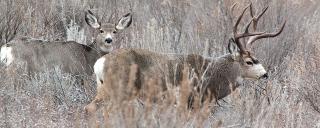 |
| Fact Sheet |
| Scientific Name |
Odocoileus hemionus |
| Description |
Averages 39 inches at the shoulder (range 30-42 inches). Bucks average 170 pounds (range 125-330 pounds); does average 140 pounds (range 110-210 pounds). Coat reddish-brown in summer and blue-gray in winter, with white throat, belly and rump patch. Tail slender and white, with a black tip. Only males have antlers. Main beams divide into nearly equal branches, and may divide again to form four or more tines on each side. |
Tracks |
Mule deer tracks:Front track slightly larger. Front–2-1/4" - 4" L, 1-5/8" - 2-3/4" W. Rear–2" - 3-1/2" L, 1-1/2" - 2-3/8". W Walking stride: 15" - 25" |
| Habitat |
Sagebrush plains and shortgrass prairie associated with buttes and rough badlands terrain. |
| Food |
Browse on a variety of trees, shrubs and forbs including green ash, aspen, sweetclover and sagebrush. Mule deer will also eat grass species, alfalfa and other agricultural crops. |
| Range |
Primarily found in the badlands adjacent to the Little Missouri River. Secondary range extending north and east to the breaks along the Missouri River. |
| Mating |
Breeding peaks in mid-November, with bucks tending one doe at a time. No permanent pair bonds. Gestation averages 204 days (range 183-218 days). |
| Young |
One to three fawns (usually two) born late May to late June, and weighing about 8 pounds. Coat reddish-brown, with white spots on back. |
| Habits |
Most active at dawn and dusk. Does often socialize in small groups with related females from several generations. Outside of the breeding season, bucks usually alone or in small bachelor groups. |
| Fun Facts |
When alarmed, mule deer often flee with a bouncing gait called “stotting.” Mule deer got their name because of their large ears. |


